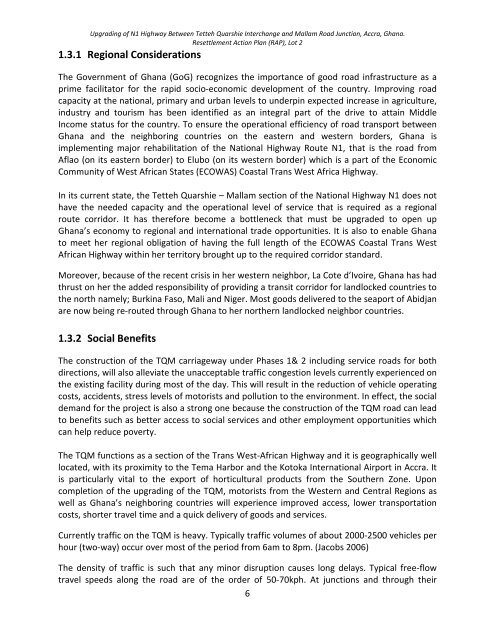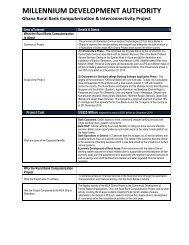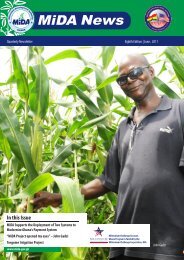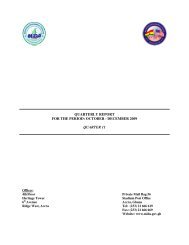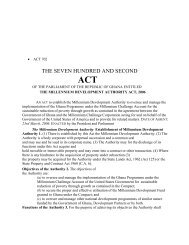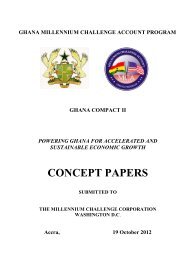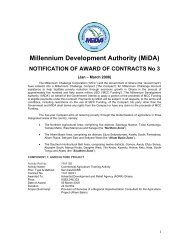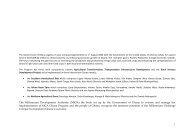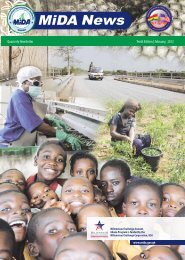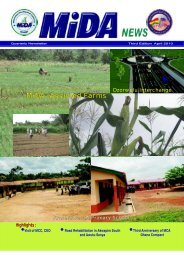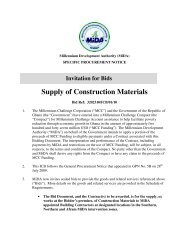Download full document - MiDA Ghana
Download full document - MiDA Ghana
Download full document - MiDA Ghana
You also want an ePaper? Increase the reach of your titles
YUMPU automatically turns print PDFs into web optimized ePapers that Google loves.
Upgrading of N1 Highway Between Tetteh Quarshie Interchange and Mallam Road Junction, Accra, <strong>Ghana</strong>.Resettlement Action Plan (RAP), Lot 21.3.1 Regional ConsiderationsThe Government of <strong>Ghana</strong> (GoG) recognizes the importance of good road infrastructure as aprime facilitator for the rapid socio-economic development of the country. Improving roadcapacity at the national, primary and urban levels to underpin expected increase in agriculture,industry and tourism has been identified as an integral part of the drive to attain MiddleIncome status for the country. To ensure the operational efficiency of road transport between<strong>Ghana</strong> and the neighboring countries on the eastern and western borders, <strong>Ghana</strong> isimplementing major rehabilitation of the National Highway Route N1, that is the road fromAflao (on its eastern border) to Elubo (on its western border) which is a part of the EconomicCommunity of West African States (ECOWAS) Coastal Trans West Africa Highway.In its current state, the Tetteh Quarshie – Mallam section of the National Highway N1 does nothave the needed capacity and the operational level of service that is required as a regionalroute corridor. It has therefore become a bottleneck that must be upgraded to open up<strong>Ghana</strong>’s economy to regional and international trade opportunities. It is also to enable <strong>Ghana</strong>to meet her regional obligation of having the <strong>full</strong> length of the ECOWAS Coastal Trans WestAfrican Highway within her territory brought up to the required corridor standard.Moreover, because of the recent crisis in her western neighbor, La Cote d’Ivoire, <strong>Ghana</strong> has hadthrust on her the added responsibility of providing a transit corridor for landlocked countries tothe north namely; Burkina Faso, Mali and Niger. Most goods delivered to the seaport of Abidjanare now being re-routed through <strong>Ghana</strong> to her northern landlocked neighbor countries.1.3.2 Social BenefitsThe construction of the TQM carriageway under Phases 1& 2 including service roads for bothdirections, will also alleviate the unacceptable traffic congestion levels currently experienced onthe existing facility during most of the day. This will result in the reduction of vehicle operatingcosts, accidents, stress levels of motorists and pollution to the environment. In effect, the socialdemand for the project is also a strong one because the construction of the TQM road can leadto benefits such as better access to social services and other employment opportunities whichcan help reduce poverty.The TQM functions as a section of the Trans West-African Highway and it is geographically welllocated, with its proximity to the Tema Harbor and the Kotoka International Airport in Accra. Itis particularly vital to the export of horticultural products from the Southern Zone. Uponcompletion of the upgrading of the TQM, motorists from the Western and Central Regions aswell as <strong>Ghana</strong>’s neighboring countries will experience improved access, lower transportationcosts, shorter travel time and a quick delivery of goods and services.Currently traffic on the TQM is heavy. Typically traffic volumes of about 2000-2500 vehicles perhour (two-way) occur over most of the period from 6am to 8pm. (Jacobs 2006)The density of traffic is such that any minor disruption causes long delays. Typical free-flowtravel speeds along the road are of the order of 50-70kph. At junctions and through their6


